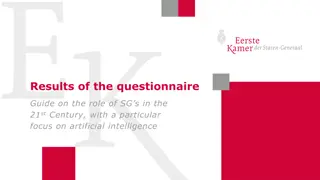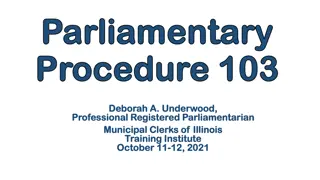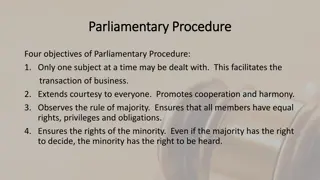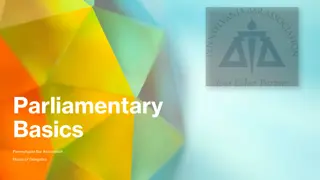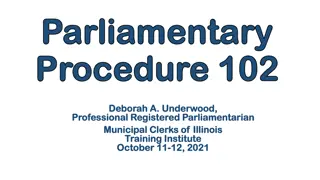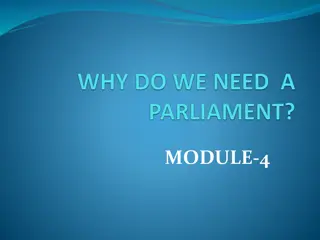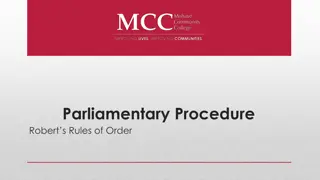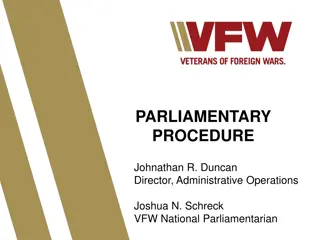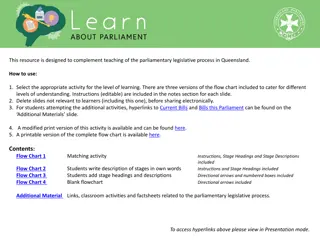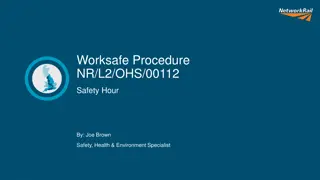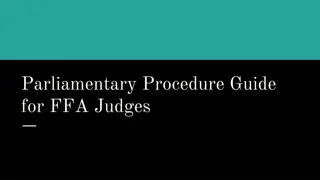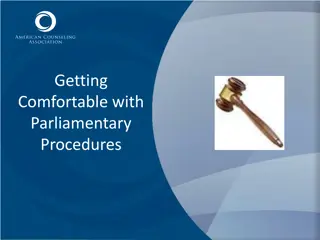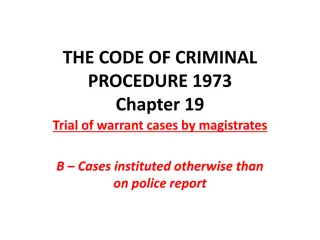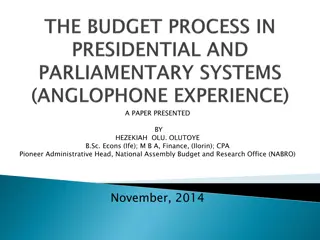Parliamentary Procedure Essentials
Learn about the role of parliamentary procedure in effective meeting management, the principles and rules governing it, the important role of the chair, the necessity of quorum, and the basic process for motions. Understand the importance of maintaining order, facilitating discussions, and making decisions in a structured and inclusive manner.
Download Presentation

Please find below an Image/Link to download the presentation.
The content on the website is provided AS IS for your information and personal use only. It may not be sold, licensed, or shared on other websites without obtaining consent from the author.If you encounter any issues during the download, it is possible that the publisher has removed the file from their server.
You are allowed to download the files provided on this website for personal or commercial use, subject to the condition that they are used lawfully. All files are the property of their respective owners.
The content on the website is provided AS IS for your information and personal use only. It may not be sold, licensed, or shared on other websites without obtaining consent from the author.
E N D
Presentation Transcript
Role of Parliamentary Procedure Effective meeting management Arrive at the general will on the greatest number of questions in the minimum amount of time, while being inclusive Reach decisions regardless of whether there is total harmony or impassioned division of opinion
Principles of Parliamentary Procedure All voices are heard Ability for each member to provide input on topics All members have equal rights, privileges, and obligations Full and free discussion with a diversity of ideas Maintenance of order
Role of the Chair Introduces agenda items and provides factual context Recognizes speakers Keeps discussion centered on current item/motion Facilitates votes on motions and other items, and announces the results Ensures that all members understands exactly what is being voted on Remains impartial during the debate Maintains the integrity of the parliamentary process
Quorum Must have quorum to make decisions Majority of voting members (more than half) Must be maintained throughout meeting
Basic Process for Motions Member obtains recognition of the chair Member makes a motion Motion must be seconded by another member Chair states the motion and opens debate Maker of motion may speak first in debate Debate ensues Chair puts the question, aka facilitates the vote Chair announces the results Note: Brown Act requires all votes be listed in the minutes
Rules of Engagement Collegiality and supporting students is the common goal Debate ideas, not personalities Keep debate focused on the current motion/item being considered All remarks are addressed to the chair
General Rules of Debate (partial) Members may only speak if recognized by chair All discussion must be relevant to motion/item Members may speak up to twice on a motion/item Each time, members may speak up to 10 minutes Members that have yet to speak in a motion/item have preference When possible, alternate between pro and con speakers
Request for Information, Parliamentary Inquiry, and Point of Order Request for Information Inquiry as to the facts affecting the business at hand Parliamentary Inquiry Request for the Chair s opinion on a matter of parliamentary procedure as it relates to the business at hand (not a ruling) Point of Order May interrupt the current speaker if timely Member calls attention to a violation of the rules of the assembly Must be raised promptly at the time the breach occurs
A Few Common Motions Motion Wording Second? Debate? Amend? Vote Main motion I move to Yes Yes Yes Majority Amend I move to amend the motion Yes Yes Yes Majority Commit or Refer I move that [X] be referred to a committee Yes Yes Yes Majority Postpone I move to postpone Yes Yes Yes Majority Previous question (end debate) I move the previous question Yes No No 2/3 Request for information I have a request for information No No No -- Parliamentary inquiry I would like to make a parliamentary inquiry No No No -- Point of order Point of order! No No No --






